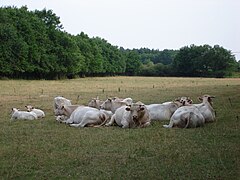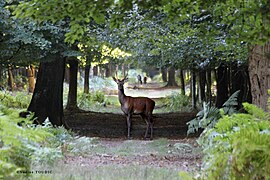User:Davric/Museum of Sologne
 | |
| Established | 1950 |
|---|---|
| Location | Romorantin-Lanthenay (France) |
| Website | Museum website |
History of the museum[edit]
The museum was created in the 1950. It was then rehabilitated in new premises in 1995 (in the old mills of the chapter and the town spanning the Sauldre, as well as in the Jacquemart tower (for temporary exhibitions).
It was labeled Musée de France on February 1, 2003 [1] .
The museum consists of three buildings, the chapter mill, the town mill and the Tour Jacquemard. The latter housing the temporary exhibitions.
The Chapter Mill[edit]
Originally formed from two separate mills, it operated until the 1970s [2]. It constitutes the heart of the museum.
The town mill[edit]
Owned by François 1er, it was sold in 1540. The mill was bought in 1971 by the city from the Normant sheet manufacturer. This part of the museum mainly represents the economy of the city.
The Jacquemart Tower[edit]
Built around the XII or XIII century, it was part of the fortified city wall. It marked the southern entrance to the city. It is the site of the museum's temporary exhibitions.
Collections[edit]
It also houses a documentation center on Sologne containing in particular a library where the collection Émile-Martin is kept including many old works of botany.
Codex Arundel[edit]
In 2011, Carlo Pedretti, Italian historian, honorary citizen of the town of Romorantin-Lanthenay, donated a facsimile of the Codex Arundel, an old book by Leonardo da Vinci in order to create a documentary background on the Italian author[3]. It brings together many drawings by the artist-researcher and in particular the project of a palace on the banks of the Sauldre[4].
the collections[edit]
Clothes[edit]
The clothes are special and practical in the Sologne region. The women wore bonnet (the "cuddle") and wore an apron on a skirt in drug and a caraco in cotton. Men, meanwhile, wore a large and loose outfit to facilitate work. These were often drugstore pants and a blue blouse (the "biaude"). Sunday was an opportunity to wear more elaborate and enriched clothing, with jewelry, cashmere and ceremonial headdresses.
Beliefs[edit]
If the Solognot, historically, were attached to the Christian religion. Nevertheless, there is much evidence of pagan rites or beliefs. Many testimonies of these rites are exhibited at the museum with, among other things, models of the fountains of Saint-Thibaut in Ménestreau-en-Villette, from Saint-Baudemir to Bauzy which were reputed to have virtues healing.
Habitat[edit]
The museum houses a number of reconstructions of interiors and models of buildings. The Sologne farms are represented with their original materials: wood, cob, bricks, etc.
Hunting[edit]
Sologne, home to nearly 500 castles[5] is very well known for hunts. It is therefore quite logical that the museum presents hunting and poaching.
Fauna and flora[edit]
The Sologne being mainly composed of ponds, forests and moors, the fauna and flora are adapted to these different natural environments. If big game ( wild boar, deer) are emblematic of Sologne, they are not the only animals, amphibians, [[Desmognathus ochrophaeus | salamanders] ] and others are very present in the region.
-
Sologne cows
-
Jacquemeard tower
-
Sologne pond
-
Bourillon river at Marcilly-en-Villette
-
Paysage de Sologne
-
Canal de la Sauldre at Lamotte-Beuvron
-
Canal de la Sauldre at Lamotte-Beuvron
-
The Beuvron at Bracieux
-
A daguet









